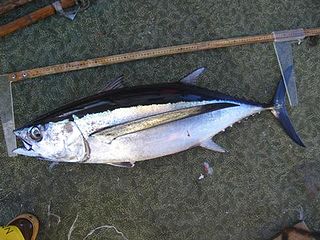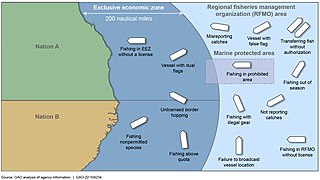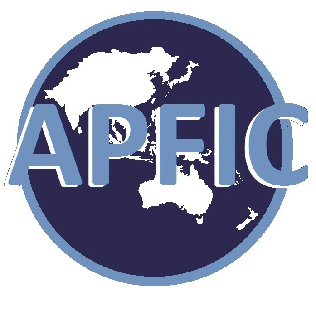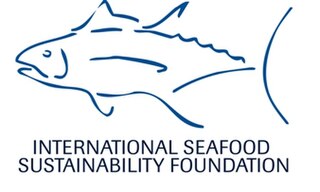Related Research Articles

Fishery can mean either the enterprise of raising or harvesting fish and other aquatic life or, more commonly, the site where such enterprise takes place. Commercial fisheries include wild fisheries and fish farms, both in freshwater waterbodies and the oceans. About 500 million people worldwide are economically dependent on fisheries. 171 million tonnes of fish were produced in 2016, but overfishing is an increasing problem, causing declines in some populations.

The albacore, known also as the longfin tuna, is a species of tuna of the order Scombriformes. It is found in temperate and tropical waters across the globe in the epipelagic and mesopelagic zones. There are six distinct stocks known globally in the Atlantic, Pacific, and Indian oceans, as well as the Mediterranean Sea. The albacore has an elongate, fusiform body with a conical snout, large eyes, and remarkably long pectoral fins. Its body is a deep blue dorsally and shades of silvery white ventrally. Individuals can reach up to 1.4 m in length.

Overfishing is the removal of a species of fish from a body of water at a rate greater than that the species can replenish its population naturally, resulting in the species becoming increasingly underpopulated in that area. Overfishing can occur in water bodies of any sizes, such as ponds, wetlands, rivers, lakes or oceans, and can result in resource depletion, reduced biological growth rates and low biomass levels. Sustained overfishing can lead to critical depensation, where the fish population is no longer able to sustain itself. Some forms of overfishing, such as the overfishing of sharks, has led to the upset of entire marine ecosystems. Types of overfishing include: growth overfishing, recruitment overfishing, ecosystem overfishing.

The Common Fisheries Policy (CFP) is the fisheries policy of the European Union (EU). It sets quotas for which member states are allowed to catch each type of fish, as well as encouraging the fishing industry by various market interventions. In 2004 it had a budget of €931 million, approximately 0.75% of the EU budget.
The Northwest Atlantic Fisheries Organization (NAFO) is an intergovernmental organization with a mandate to provide scientific advice and management of fisheries in the northwestern part of the Atlantic Ocean. NAFO is headquartered in Halifax, Nova Scotia, Canada.

The National Marine Fisheries Service (NMFS), informally known as NOAA Fisheries, is a United States federal agency within the U.S. Department of Commerce's National Oceanic and Atmospheric Administration (NOAA) that is responsible for the stewardship of U.S. national marine resources. It conserves and manages fisheries to promote sustainability and prevent lost economic potential associated with overfishing, declining species, and degraded habitats.

Illegal, unreported and unregulated fishing (IUU) is an issue around the world. Fishing industry observers believe IUU occurs in most fisheries, and accounts for up to 30% of total catches in some important fisheries.
The Fishery Resources Monitoring System (FIRMS) is a partnership of intergovernmental fisheries organizations that share information on the global monitoring and management of marine fishery resources.
The South East Atlantic Fisheries Organisation (SEAFO) is an organization that maintains controls over fishing and fishing related acts in the Southeastern Atlantic Ocean.

The Asia-Pacific Fishery Commission (APFIC), originally called the Indo-Pacific Fisheries Council (IPFC) is a Food and Agriculture Organization (FAO) Article XIV Regional Fisheries Body which covers fisheries, aquaculture and related aquatic resource issues in the Asia-Pacific region. APFIC functions as a Regional Consultative Forum raising awareness amongst member countries, fisheries organizations and fisheries professionals in the Asia-Pacific region.

As with other countries, the 200 nautical miles (370 km) exclusive economic zone (EEZ) off the coast of the United States gives its fishing industry special fishing rights. It covers 11.4 million square kilometres, which is the second largest zone in the world, exceeding the land area of the United States.

The Western and Central Pacific Fisheries Commission (WCPFC) is both a general and a tuna regional fisheries management organisation established to conserve and manage tuna and other highly migratory fish stocks across the western and central areas of the Pacific Ocean. Its full name is Commission for the Conservation and Management of Highly Migratory Fish Stocks in the Western and Central Pacific Ocean. It commenced operations in late 2005, and its secretariat is based in Pohnpei, in the northern Pacific state of the Federated States of Micronesia.

International Seafood Sustainability Foundation (ISSF) was formed in 2009 as a global, non-profit partnership among the tuna industry, scientists and World Wide Fund for Nature. The multistakeholder group states its mission is "to undertake science-based initiatives for the long-term conservation and sustainable use of tuna stocks, reducing bycatch and promoting ecosystem health". Regional Fisheries Management Organizations (RFMOs) are primarily responsible for managing the world's tuna stocks—skipjack, yellowfin and albacore tuna, the species most commonly processed for canned and shelf-stable tuna products, but their parliamentary procedures too often allow the short-term economic and political interests of nations to prevent sustainable measures from being adopted. ISSF works to ensure that effective international management practices are in place to maintain the health of all the tuna stocks.
The Coordinating Working Party on Fishery Statistics (CWP) provides a mechanism to coordinate fishery statistical programmes of regional fishery bodies and other inter-governmental organizations with a remit for fishery statistics.
Dr. Moritaka Hayashi is an international lawyer, scholar and author, who is widely considered a leading expert on the impact of human activity on the world's oceans. Over a period of nearly 40 years, he has published extensively on issues involving the law of the sea, including overfishing, maritime shipping and maritime security. In 2008, he served on an international commission that generated controversy by calling for the immediate suspension of bluefin tuna fishing in the Eastern Atlantic Ocean and Mediterranean Sea. He has also served as an official at the United Nations and as a diplomat for the Permanent Mission of Japan to the United Nations.

The Pacific Islands Forum Fisheries Agency (FFA) is an intergovernmental agency established in 1979 to facilitate regional co-operation and co-ordination on fisheries policies between its member states in order to achieve conservation and optimum utilisation of living marine resources, in particular highly migratory fish stocks, for the benefit of the peoples of the region, in particular the developing countries. The office campus is located in Honiara, Solomon Islands
The following outline is provided as an overview of and topical guide to fisheries:
High seas fisheries management refers to the governance and regulation of fishing activities in areas beyond national jurisdiction, often referred to as the 'high seas'. The 1982 United Nations Convention on the Law of the Sea (UNCLOS) and the 1995 United Nations Fish Stock Agreement (UNFSA) provide the international legal framework for the regulation of fishing activities in areas beyond national jurisdiction. The United Nations Fish Stock Agreement delegates responsibility for conservation and management of fish stocks to regional fisheries management organizations (RFMOs) each governing a geographical area of the high seas.
Illegal, unreported and unregulated fishing (IUU) in the Arctic is an under researched scientific field. The most recent academic articles about IUU in the Arctic mainly concerns the mid-2000s.
The fishing industry in Thailand, in accordance with usage by The World Bank, the UN's Food and Agriculture Organization (FAO) and other multinational bodies, refers to and encompasses recreational fishing, aquaculture, and wild fisheries both onshore and offshore.
References
- ↑ "FAO Fisheries & Aquaculture - Regional Fisheries Bodies (RFB)". www.fao.org. Food and Agriculture Organisation. Retrieved 22 April 2017.
- ↑ "FAO Fisheries & Aquaculture". www.fao.org. Retrieved 2024-01-02.
- ↑ "Regional Fishery Bodies | Vulnerable Marine Ecosystems | 联合国粮食及 农业组织". www.fao.org. Retrieved 2024-01-02.
- 1 2 1. billè 2. chabason 3. drankier 4. molenaar 5. rochette, 1. raphael 2. lucien 3. petra 4. erik j. 5. julien (2016). Regional Oceans Governance Making Regional Seas Programmes, Regional Fishery Bodies and Large Marine Ecosystem Mechanisms Work Better Together (1st ed.). nairobi: UNEP Regional Seas Programm. p. 4.
{{cite book}}: CS1 maint: numeric names: authors list (link) - ↑ Regional fisheries management organisations (RFMOs), Retrieved 2012-01-05.
- 1 2 3 4 1. Løbach 2. Petersson 3. Haberkon, 1. Teje 2. Matilda 3. Eliana (2020). "Activities and developments, 2000–2017". Regional fisheries management organizations and advisory bodies (2nd ed.). Rome: FAO Fisheries and Aquaculture Technical Paper No. 651. p. 7. ISBN 978-92-5-132237-6.
{{cite book}}: CS1 maint: numeric names: authors list (link) - 1 2 1. ribeiro 2. loureiro bastos 3. henriksen, 1. marta chantal 2. fernando 3. tore (2020). Global Challenges and the Law of the Sea (1st ed.). switzerland: springer. p. 83. ISBN 978-3-030-42670-5.
{{cite book}}: CS1 maint: numeric names: authors list (link) - ↑ 1. ceo 2. fagnai 3. swan 4. tamada 5. watanabe, 1. marika 2. sarah 3. judith 4. kumiko 5. hiromoto (2012). PERFORMANCE REVIEWS BY REGIONAL FISHERY BODIES: INTRODUCTION, SUMMARIES, SYNTHESIS AND BEST PRACTICES Volume I: CCAMLR, CCSBT, ICCAT, IOTC, NAFO, NASCO, NEAFC (1st ed.). rome: fao. p. 3.
{{cite book}}: CS1 maint: numeric names: authors list (link) - ↑ The official UN FAO directory of all recognised RFBs, including RFMOs by type, as well as RFABs
- ↑ http://www.tuna-org.org/ List of the five tuna RFMOs, Retrieved 2009-10-07.
- ↑ http://www.seaaroundus.org/OtherWebsites/2010/EcoPolitology_ResearchShowsWorldsFisheriesManagementSystemFailingMiserably.pdf [ bare URL PDF ]
- ↑ "Regional fisheries management organisations (RFMOs) - European Commission". oceans-and-fisheries.ec.europa.eu. 2023-12-08. Retrieved 2024-01-02.